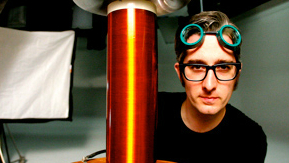Bre Pettis on The Disruptive Future of 3D Printing

We recently released our latest Deep Dive report which examines the dynamic web of cultural activity that makes up the Hackdesign Content Network. In Hackdesign, the new “maker movement” updates traditional DIY ideas of repair, often through open source technology and craftiness. The results are creative, playful and ultimately useful inventions that take technology and design to new levels of imagination.
In our report, we suggest that Hackdesign will continue to become more mainstream, and that a sense of play and a desire to remake the world will drive the movement. But of all the trends and themes we see coming out of Hackdesign, perhaps none is more significant in its potential to disrupt traditional industries, economies and the wider culture than 3D Printing.
What is 3D printing?
Unless you follow bleeding edge technology or count yourself amongst the DIY enthusiasts creating with the machines, 3D printing may be a foreign term. The process works similarly to traditional printers, with the added dimension of height. Using a computerized 3D model as the source file, layers of a material (typically plastic) are sprayed on top of each other until a full form is created.
3D printing is not new; it’s been around since the late 1980s in the form of rapid prototyping machines used in the product development process. What is new is the development of affordable 3D printers that have enabled creative minds around the world to run wild with innovative printed objects.
Over the past few years we’ve seen amateur 3D printing progress from an act of simple creative exploration to its current state of sophistication. Modern uses of 3D printing can be found in a wide range of industries, from architecture to medicine, and a host of concerns have sprung up around issues of copyright infringement and the printing of regulated items like guns.
Bre Pettis is an innovator in the DIY 3D printing space. Since 2009 his Brooklyn-based company, Makerbot Industries, has built accessible printers that it hopes will inspire a home 3D printing movement. Makerbot recently launched the Replicator 2 Desktop 3D Printer, an updated version of their home 3D printer. We caught up with the Wired cover star recently to explore the future of this nascent technology:
1. 3D Printing is gaining strength, but it’s still a fringe activity. Have you seen any uses of the technology that have broken through to the mainstream?
In the past year, desktop 3D printing has become a part of mainstream prototyping and additive manufacturing processes with leading corporations, organizations and universities around the world. MakerBots are used to make just about anything, including gear sets, model cars and tractors, engines and even vascular skin!
2. How do you see the 3D printing revolution disrupting industries?
We are at the edge of a massive transformation in the way that products are designed and produced. Right now, it takes a design team and engineering team to prototype a product and a massive manufacturing infrastructure to bring it to market. With a 3D printer, an individual can design something that they think should exist in the world and make a true to life model that they can hold in their hands in hours. Because the material is affordable, they can iterate as many times as necessary. What used to take months of time and teams of people to create a product can take hours with ownership of a MakerBot. Entrepreneurs, engineers, designers, and creative explorers around the world are now primed to disrupt the basic infrastructure of industrial design and manufacturing. Having a MakerBot gives individuals the power of prototyping and small scale manufacturing in a package that fits on your desktop.
3. How far can this go? What are the most ambitious projects you have come across recently?
Some of the most impressive projects are in the medical field.
Jordan Miller, a researcher at the University of Pennsylvania in Philadelphia, used a MakerBot desktop 3D printer to make vascular skin tissue. His paper was published in the journal Nature Materials
Seth Horowitz, Assistant Professor in the Department of Ecology at Brown University, uses a desktop 3D printer to make models of a human inner ear.
Dr. Joseph Giovinco, a foot and ankle surgeon in Atlanta uses a MakerBot desktop 3D printer to make anatomically correct models of his patient’s pre-operative foot and the post-operative foot to save time during surgery. His paper was published in The Journal of Foot & Ankle Surgery.
4. Should we be concerned about counterfeiting?
No, you should be excited to be on the edge of a new industry that will transform the way we think about things and how they are made.
3D printing is just one of the many themes in the Hackdesign Content Network that we’re tracking. The “Play to Purpose” ethos of Hackdesign is growing and will to continue to spread throughout culture, as evidenced by the excitement and interest surrounding this year’s massive World Makers Faire (which we’ll be attending this weekend). Also look for commercial and community-based workshops, along with the proliferation of new marketplaces, to fuel the trend and inspire people to take a more active role in creating and upgrading the elements of their world.
sparks & honey is a next generation agency that helps brands synchronize with culture. Download our Hackdesign Deep Dive report here.




